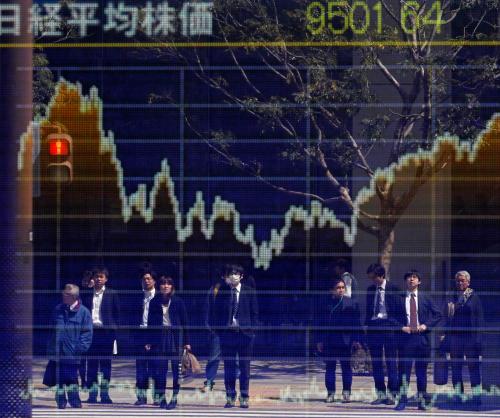The world does not seem to face much risk in the short term. But in the medium to long term, rising income inequality, exacerbated by the mismatch between skills and jobs in the digital age, will become a significant impediment to growth, unless policymakers implement a wide array of difficult structural reforms. This commentary was originally published on Project Syndicate.
Economic growth is accelerating across most of the world. Yet the world’s total gross debt-to-GDP ratio has reached nearly 250 percent, up from 210 percent before the global economic crisis nearly a decade ago, despite post-crisis efforts by regulators in many important economies to drive the banking sector to deleverage. This has raised doubts about the sustainability of the recovery, with some arguing that a rise in interest rates could trigger another global crisis. But how likely is that to happen?
To answer this question, one must recall that debt is both a liability and an asset. In a closed economy—and we don’t owe anything to non-Earthlings—overall debt and the corresponding assets necessarily cancel each other out. So what really matters is the composition of debts and liabilities—or, to put it simply, who owes what to whom.
High public-sector debt, for example, signals the possible need for tax increases—the opposite of the tax legislation being advanced by Republican legislators in the United States—and/or higher interest rates (real or nominal, depending on monetary policy and inflation). If debt is owed largely to foreign lenders, interest-rate risk is compounded by exchange-rate risk.
For private-sector debt, much depends on its type: the hedging sort, where a debtor’s cash flow covers all obligations; the speculative type, where cash flow covers interest only; or the Ponzi kind, where cash flow does not even cover that. As the late American economist Hyman Minsky explained, the higher the share of debt that falls into the speculative or Ponzi categories, the higher the risk that a confidence shock will trigger a sudden wave of deleveraging that quickly morphs into a full-blown financial crisis.
For both public- and private-sector debt, maturities also play an important role. Longer maturities leave more time for adjustment, lowering the risk of a confidence shock.
Yet while it makes little sense to focus on simple aggregate figures, both public institutions and private researchers tend to do precisely that. Consider the coverage of the Greek debt crisis. Headlines tracked the debt-to-GDP ratio’s climb from 100 percent in 2007 to 180 percent this year, yet little attention was paid to private-sector debt. And, in fact, as foreign public creditors replaced private debt holders and interest rates were lowered, Greece’s overall debt, while still high, became more sustainable. Its continued sustainability will depend partly on the trajectory of Greece’s GDP—the denominator in the debt ratio.
A similar mistake is made in assessing China’s debts, about which the world is most concerned. The figures are certainly daunting: China’s debt-to-GDP ratio now stands at about 250 percent, with private-sector debt amounting to about 210 percent of GDP. But about two-thirds of the private-sector debt that is defined as bank loans and corporate bonds is actually held by state-owned enterprises and local-government entities. The central government has considerable control over both.
For China, the biggest risk probably lies in the shadow banking sector, on which reliable data are not available. On the other hand, a significant share of the growth in private debt ratios in recent years may be a result of the “formalization” of parts of the shadow banking system—a trend that would bode well for economic stability.
And there is more good news for China. Most Chinese debt is held in renminbi; the country possesses massive foreign-exchange reserves of close to $3 trillion; and capital controls are still effective, despite having been eased in recent years. The country’s leaders thus have a public-policy war chest that they can use to cushion against financial turmoil.
Among the rest of the emerging economies, there are some sources of concern. But, overall, the situation is relatively stable. Though private-sector debt has lately been rising, its levels remain tolerable. And public-sector debt has been growing only moderately, relative to GDP.
As for the advanced economies, there is little reason to believe that a debt crisis is around the corner in Japan. In the U.S., public debt is set to increase, thanks to the impending tax overhaul; but the blow will be cushioned, at least for the next year or two, by continued growth acceleration. And though low-quality assets held by the banking system are likely to impede Europe’s recovery, they are unlikely to spark a financial crisis.
In short, the world does not seem to face much risk of a debt crisis in the short term. On the contrary, the stage seems to be set for continued increases in asset valuations and demand-driven growth.
That said, geopolitical risks should not be discounted. While markets tend to shrug off localized political crises and even larger geopolitical challenges, some dramas may be set to spin out of control. In particular, the North Korean nuclear threat remains acute, with the possibility of a sudden escalation raising the risk of conflict between the U.S. and China.
The Middle East remains another source of serious instability, with tensions in the Gulf having intensified to the point that hostilities between Iran and Saudi Arabia and/or turmoil within Saudi Arabia are not unthinkable. In this case, it is Russia that might end up clashing with the U.S.
Even barring such a major geopolitical upheaval, which would severely damage the global economy’s prospects in the short run, serious medium- and long-term risks loom. Rising income inequality, exacerbated by the mismatch between skills and jobs in the digital age, will impede growth, unless a wide array of difficult structural reforms are implemented, including reforms aimed at constraining climate change.
As long as the geopolitical situation remains manageable, policymakers should have time to implement the needed structural reforms. But the window of opportunity will not stay open forever. If policymakers waste time on trickle-down sophistry, as is happening in the U.S., the world may be headed for severe economic distress.
The Brookings Institution is committed to quality, independence, and impact.
We are supported by a diverse array of funders. In line with our values and policies, each Brookings publication represents the sole views of its author(s).






Commentary
Op-edIs another debt crisis on the way?
December 18, 2017